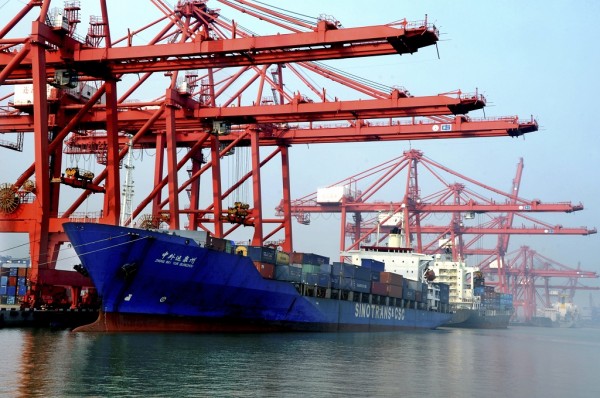China's Port Ore Inventories Down, Nickel Deficit Becomes More Apparent
| Eana Maniebo | | May 09, 2015 07:18 AM EDT |
(Photo : Reuters) Chinese ports are expected to bottom out their inventories by April this year, according to Shanghai Metals Market (SMM).
The mining industry is moving closer to a mineral supply deficit as China uses up the nickel ore inventories in its five major ports, several reports said.
A report from Metals.com revealed that last week, ore inventories at China's ports Tianjin, Rizhao, Lanshan, Lianyungang, and Jingtang were down by 145,000 tons to 11.71 million tons. The week prior to that, total nickel ore inventories were standing at 11.85 million tons, down by 289,000 tonnes per week.
Like Us on Facebook
Mining Weekly reported in November that the Chinese ports are expected to bottom out their inventories by April this year, according to Shanghai Metals Market (SMM). China's port stockpiles make up 70 percent of its port inventories.
In October, nickel ore stocks stood at 17.2 million tonnes, representing a decrease by 3.12-million tonnes or 17 percent year-on-year, SMM data showed. It also estimated China's nickel to be around 21.81 million tonnes, 15.81 million tonnes of which is available.
But as of January 23 this year, China's imports have dropped by 504,000 million tonnes week-on-week to 12.45 million tonnes, according to Hellenic Shipping News.
In December, nickel ores and concentrates shipments to the country were down to 2.48 million tonnes, representing a 61.7 percent decline year-on-year, and 13.3 percent decline month-on-month, data from the General Administration of Customs revealed.
While China added imports from the Philippines, the second largest ore supplier globally after Indonesia, to 73.3% year-on-year to 2.41 million in December, it was trumped by a 100 percent decline in imports from Indonesia. Before it imposed a ban on exports of raw minerals, Indonesia was China's largest nickel ore and concentrate supplier.
The shipments are forecasted to climb back to normal levels only after March, Hellenic Shipping said. Analysts maintain that the imports will "continue falling" as Philippine mines are affected by monsoon season.
Nickel's journey was a bumpy one last year following Indonesia's implementation of an export ore ban in early January. The country imposed the curb to bring investments into the local economy through the construction of new ore processing plants. Prior to the ban, the country was rumored to impose a "tamer phased ban," according to a report on Nickel Investing News.
The ban pushed nickel prices up to an all-time high in May, which trickled down to the share prices of other "nickel-focused" companies outside the Southeast Asian country. Indeed, most companies are optimistic about the trends in nickel prices as an offshoot of the ban. Amur Minerals Corporation (OTC:AMMCF) chief executive Robin Young, for instance, was bullish about the trend.
"We're very encouraged in this and we have a great neighbor to the Southwest, in China, who is a very hungry nickel consumer," Amur chief executive Robin Young said in an interview with BRR Media. Amur Minerals currently runs and operates the Kun-Manie mine in the Amur Oblast which is ranked as one of the top 20 largest nickel mines in the world.
Glencore's (LSE:GLEN) Kenny Ives also expect the deficit would be in favor of nickel players. According to Platts, he announced during last month's investor day that he expects a "balanced 2015" and a deficit to appear after that point until 2018.
Charlotte McLeod, a columnist at Nickel Investing, also echoes Ives's claims. "Whether 2015 brings a deficit or merely stability, nickel market participants will likely be pleased to get some relief from the turmoil of the past few years," she noted.
TagsChina port ore, stocked ore in China, nickel supply in China, Nickel supply deficit, Glencore's, Amur Minerals, Amur Minerals Corp, nickel suppliers, China supply and demand, status of Chinese ports, Indonesian Ore Ban, China's port stockpiles
©2015 Chinatopix All rights reserved. Do not reproduce without permission
EDITOR'S PICKS
-

Did the Trump administration just announce plans for a trade war with ‘hostile’ China and Russia?
-

US Senate passes Taiwan travel bill slammed by China
-

As Yan Sihong’s family grieves, here are other Chinese students who went missing abroad. Some have never been found
-

Beijing blasts Western critics who ‘smear China’ with the term sharp power
-

China Envoy Seeks to Defuse Tensions With U.S. as a Trade War Brews
-

Singapore's Deputy PM Provides Bitcoin Vote of Confidence Amid China's Blanket Bans
-

China warns investors over risks in overseas virtual currency trading
-

Chinese government most trustworthy: survey
-

Kashima Antlers On Course For Back-To-Back Titles
MOST POPULAR
LATEST NEWS
Zhou Yongkang: China's Former Security Chief Sentenced to Life in Prison

China's former Chief of the Ministry of Public Security, Zhou Yongkang, has been given a life sentence after he was found guilty of abusing his office, bribery and deliberately ... Full Article
TRENDING STORY

China Pork Prices Expected to Stabilize As The Supplies Recover

Elephone P9000 Smartphone is now on Sale on Amazon India

There's a Big Chance Cliffhangers Won't Still Be Resolved When Grey's Anatomy Season 13 Returns

Supreme Court Ruled on Samsung vs Apple Dispute for Patent Infringement

Microsoft Surface Pro 5 Rumors and Release Date: What is the Latest?










